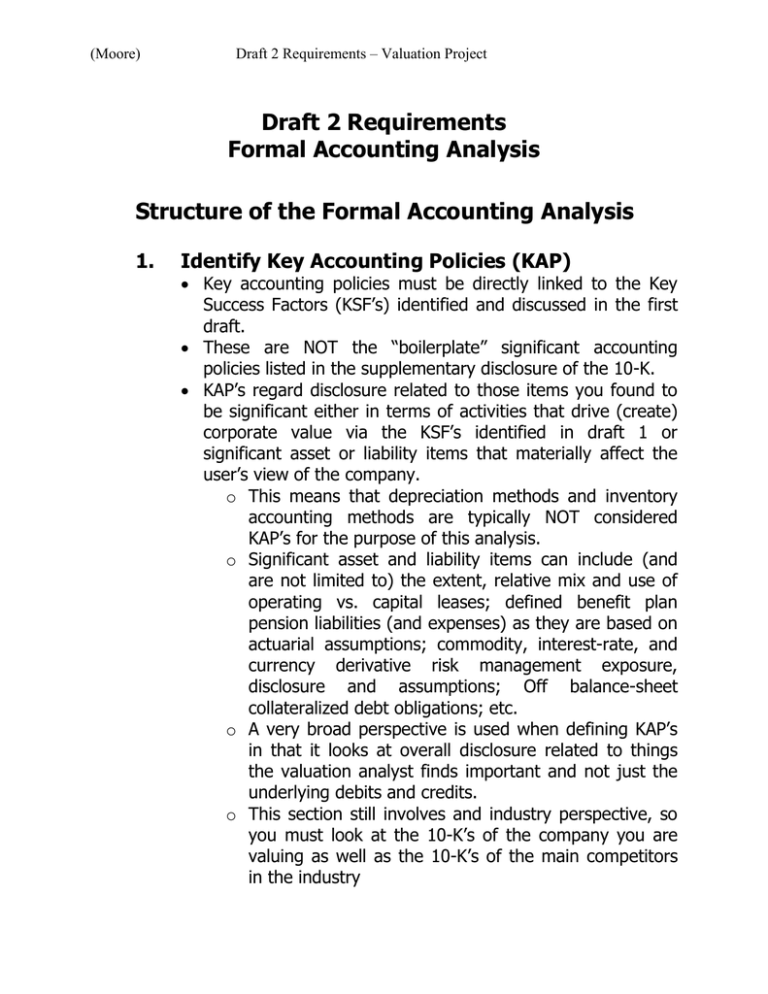Draft 2 Requirements Formal Accounting Analysis Structure of the Formal Accounting Analysis
advertisement

(Moore) Draft 2 Requirements – Valuation Project Draft 2 Requirements Formal Accounting Analysis Structure of the Formal Accounting Analysis 1. Identify Key Accounting Policies (KAP) Key accounting policies must be directly linked to the Key Success Factors (KSF’s) identified and discussed in the first draft. These are NOT the “boilerplate” significant accounting policies listed in the supplementary disclosure of the 10-K. KAP’s regard disclosure related to those items you found to be significant either in terms of activities that drive (create) corporate value via the KSF’s identified in draft 1 or significant asset or liability items that materially affect the user’s view of the company. o This means that depreciation methods and inventory accounting methods are typically NOT considered KAP’s for the purpose of this analysis. o Significant asset and liability items can include (and are not limited to) the extent, relative mix and use of operating vs. capital leases; defined benefit plan pension liabilities (and expenses) as they are based on actuarial assumptions; commodity, interest-rate, and currency derivative risk management exposure, disclosure and assumptions; Off balance-sheet collateralized debt obligations; etc. o A very broad perspective is used when defining KAP’s in that it looks at overall disclosure related to things the valuation analyst finds important and not just the underlying debits and credits. o This section still involves and industry perspective, so you must look at the 10-K’s of the company you are valuing as well as the 10-K’s of the main competitors in the industry (Moore) Draft 2 Requirements – Valuation Project 2. Assess Degree of Potential Accounting Flexibility 3. Evaluate Actual Accounting Strategy 4. Again, this relates to the flexibility related to those items you identify as KAP’s. Be specific. Use institutional knowledge of GAAP and look at relative disclosures among firms in the industry. Accounting strategy includes two basic dimensions: o First, you need to assess whether your company is a high disclosure company (levels of dis-aggregation, segment reporting, extensive discussion and disclosure within the financial report related to those items you find important in assessing value) vs. low disclosure (minimal reporting that satisfies GAAP). o Second, you need to assess (within the confines of accounting flexibility on the KAP’s whether the company is conservative (leads to lower reported earning) or aggressive (leads to higher reported earnings) in its choice of accounting policies. Make sure to do this on an absolute and relative basis. Evaluate the Quality of Disclosure Qualitative Analysis o This is essentially a matter of opinion (logical argumentation) that is grounded in supportive facts that lead to your conclusion. Main issue is overall transparency and decision usefulness of the financial reporting information. Ultimately, does the financial information presented by the company provide sufficient decision useful information that satisfies your information needs (level of disclosure, discussion, analysis, dis-aggregation, appropriate segment disclosure, etc. This analysis should be prepared on both an absolute and relative basis. 5. Identify Potential “Red Flags” Previous Qualitative and Quantitative Factors. Asset Write-offs. 4th quarter adjustments. transactions; Special purpose entities Related Party Draft 2 Requirements – Valuation Project (Moore) 6. Undo Accounting Distortions Should you determine that significant balance sheet and income statement items are materially misstated (for the purpose of your analysis), then restate the financial statements based upon your analysis. Items that sometimes arise are overstated inventory (resulting from understated obsolescence rates), capitalizing operating leases (GAAP is not in violation, but off-balance sheet assets and liabilities are present that materially affect your assessments of resources and liabilities); capitalizing research and development, restating collateralized debt obligations and incorporating special purpose entities into the financials. You will only want to restate when the items materially alter your perception of the underlying company. i. Goodwill > 30% of Net Fixed Assets ii. Goodwill Impairment eliminates > 30% Operating Income iii. R&D expense reduces operating income by more than 20% iv. Capitalized Operating Leases would increase noncurrent liabilities by more than 20% If the boundaries above are exceeded, then you must prepare restated financial statements in good form for the entire 5 or 6 previous years.
